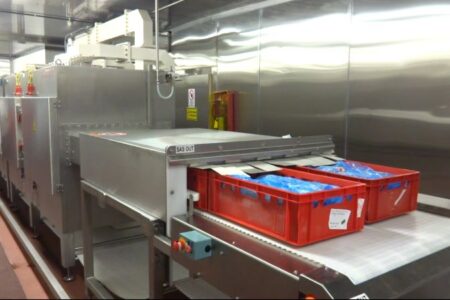Effective condition monitoring

As companies look to reduce costs, increase productivity and raise their overall equipment effectiveness scores in the face of increasingly global competition, key considerations include optimising asset utilisation, reducing waste, lowering energy consumption and maximising uptime.
Thomas Lantermann, senior business development manager at Mitsubishi Electric Europe, Factory Automation – European Business Group and Douglas Wilson of Raima look at the importance of condition monitoring. Energy consumption and the cost of unscheduled downtime are of particular concern. Legislation in place across Europe makes it essential for companies to manage energy consumption and minimize energy spikes, while the cost of unscheduled downtime for repairs can run into tens of thousands of pounds every hour. The ability to predict problems and address them pre-emptively during periods of scheduled maintenance is vital.
One of the primary tools to address these issues is condition monitoring. Here, key parameters that indicate the condition and operation of plant and machinery are continuously monitored, for example looking for significant changes that could indicate a developing fault. Typical parameters to monitor include the likes of vibration, temperature, lubricant contamination, noise and current draw.
There was a time when condition monitoring was conducted only periodically, and meant teams of Doctorate-qualified scientists poring over charts and graphs, analyzing spikes that could be indicative of machinery drifting out of balance. It was an expensive process, and only justifiable on the most costly assets or highest value production lines. But the picture has changed radically in recent years, with numerous off the shelf sensors providing simple indication that equipment is drifting out of tolerance.
Combining condition monitoring devices
Such condition monitoring is vital on high value assets but emerging condition monitoring techniques and technologies mean that it can also provide cost-effective protection for smaller machines, enabling anyone to improve efficiencies, reduce energy consumption and eliminate downtime. Individual monitoring channels can be dedicated to any and every pump, fan, motor, centrifuge, turbine or vibrating screen, providing effective and affordable condition monitoring.
The latest smart devices, combined with improvements in connectivity, fieldbus and Ethernet-based networks across all industry sectors have been key drivers behind the growing adoption of condition monitoring techniques. But an important consideration is how to collect, store, manage, analyze and act upon the vast amounts of data that are generated by numerous condition monitoring devices.
The resulting data streams certainly cannot be monitored manually, but increasingly they are also beyond traditional plant automation architectures. While PLCs (programmable logic controllers) are ideal for sequential control and some analogue processing, they don’t have the data crunching or analysis power to derive usable conclusions from large streams of condition monitoring data.
At the same time, getting these vast data streams from the plant floor to higher level databases is often problematic: traditional PC (personal computer) database solutions can be difficult, costly and time consuming to integrate with plant floor control systems, and limit the speed and volume of data transfer. In addition, once the data has been analyzed, relaying actionable information back to the automation system can be difficult to optimize.
Automation architecture
What is needed is a new approach, and it has to start within the automation architecture. Mitsubishi Electric has addressed this with its C Controller – a dedicated C-language CPU that operates standalone or mounts on standard MELSEC Q series PLC hardware. Integrating seamlessly with proven Q series I/O, networking modules and motion control cards, the C Controller CPU provides a flexible, reliable, readily expandable, rack-based PC solution as part of a multi-disciplinary automation platform.
CW Workbench is a new engineering tool from Mitsubishi Electric designed specifically for the C Controller, enabling full scale embedded systems to be developed quickly, easily and at low cost. CW Workbench offers all the essential functionality required for system development, including an editor, compiler and debugger. Mitsubishi Electric also offers a full suite of setting and monitoring tools for the C Controller CPUs, providing program-free parameter settings and program-free diagnostics. This leads to a simple means for monitoring the status of connected modules and easily performing simple debugging.
Taking the solution a step further with regard to collecting, storing, managing and analyzing the huge volumes of data associated with condition monitoring, Mitsubishi Electric has worked with e-F@ctory Alliance partner Raima to enable Raima’s RDM Embedded database technology to run on the C Controller CPU.
This provides a rugged database platform that allows data to be stored, managed and accessed directly with the controller rather than using a higher level PC database, offering huge potential for increased performance and easier integration. It allows users to take advantage of both the real time operating system, along with the C programming environment of the CPU, to customize RDM Embedded to specific application requirements.
High performance
RDM Embedded is a high performance data management solution offering the live real-time response that is needed in modern condition monitoring applications, with potentially vast streams of live event data. The highly optimized database engine supports extremely high transaction rates, and supports all mainstream real time operating systems.
In addition to real-time processing, RDM Embedded further improves response speeds with an ACID compliant database engine that supports multiple indexing methods, including B-tree and hash indexes, according to application and performance requirements. Hashing on large volumes often provides faster access to data than B-tree indexing methods.
As an example, vibration monitoring can highlight developing faults in rotating machinery. Using accelerometers, readings can be taken on machine bearing casings to measure vibration, while other sensors can measure rotating shafts to measure their radial and axial displacement. Comparing the vibration levels to historical baseline values can indicate impending bearing failure, and enable action to be taken.
Variable speed drives now provide diagnostics such as warnings on current draw values that can indicate deterioration in motor performance, or which might highlight problems in the equipment connected to the motor shaft.
At the same time, the latest generations of energy monitors can provide output of the energy consumption of everything from a single key component to a full machine. Temperature sensors and fixed-in-place thermal imaging cameras can provide useful indicators of both energy consumption and impending component failure. In industries where effective lubrication is critical, the latest generations of conductivity sensors can reliably detect levels of water in oil, long before high water levels begin to cause problems.
Future developments
And there is more to come, as condition monitoring technologies and analysis strategies become ever more sophisticated. Already we are seeing the emergence of analysis packages that can infer parameters in difficult to monitor applications. For example, looking at two parameters that can be monitored, it is then possible to infer the value of a third parameter, and take maintenance or production decisions based on that inference. Further, we can expect mathematical models to improve, and associated software to become more adept at refining both condition monitoring data and event data, enabling better and more informed decisions to be taken.
As sensors and monitoring devices become ever smarter, the quality and amount of data available will increase, with whole new levels of data about status, production efficiency, energy consumption, machine availability and more. In tandem, the rise of Machine-to-Machine (M2M) communications is driving a new model of connected intelligence, marrying efficient communications with cost-effective data transfer costs. M2M communications makes data the ultimate management tool, enabling users to implement and operate vastly more sophisticated and complex systems whilst still being able to monitor effectively what is happening within those systems.



